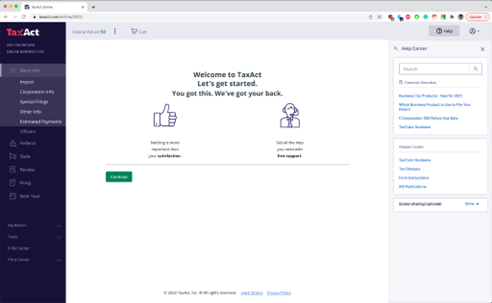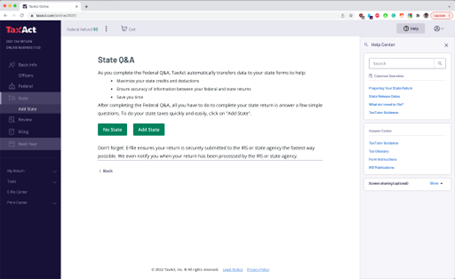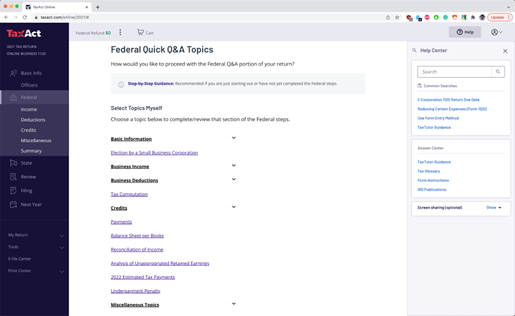We are committed to sharing unbiased reviews. Some of the links on our site are from our partners who compensate us. Read our editorial guidelines and advertising disclosure.
TaxAct for Business Review 2023
Data as of 12/7/22. Offers and availability may vary by location and are subject to change.
The bottom line: TaxAct for Business offers the most bang for your buck out of any tax software. It offers an easy-to-follow user experience with fairly inexpensive plan options. Plus, with over 150 federal tax forms and schedules and more than 45 state forms, TaxAct ensures you’ll have everything you need to file at your fingertips.
But TaxAct’s prices go up throughout tax season, it’s not available in every state, and at times its tax prompts veer into tax code jargon.
Tax season is tough, and if you’re a small-business owner, you don’t want to waste time or money on tax preparation. That’s why we did a test drive of TaxAct for Business, including filing taxes using the system, to help you find the best online tax preparer for your business.
By signing up I agree to the Terms of Use and Privacy Policy.
TaxAct plans and pricing
There are six TaxAct plans for business owners from self-employed contractors to companies with shareholders to tax-exempt nonprofits. TaxAct’s prices can reach $179.90 for federal filing plus filing in one state. But if your business wants an easy way to file, TaxAct guides you through the process and completes an e-file at the end so you don’t have to worry about mailing anything in to the IRS.
Compare TaxAct plans and pricing
Data as of 12/7/22. Offers and availability may vary by location and are subject to change.
TaxAct’s prices are fairly high for online tax software, especially when FreeTaxUSA offers a Self-Employed plan for freelancers, small businesses, and contractors for free (with a $14.99 per state file fee).
But we think TaxAct is worth it if you’re going to take advantage of its main features: multiple federal and state forms and schedules available for complex businesses plus an intuitive user interface that guides you through tax filing.
Unfortunately, TaxAct, like many other online providers, increases their plan prices as the tax filing deadline nears. We found that TaxAct for Business prices increased by $30 for Sole Proprietors and $15 for Self Employed individuals, Partnerships, C Corporations, and S Corporations between February 26, 2022 and March 4, 2022.1,2,3,4 (Tax-Exempt Organizations did not have any price changes.)
Filing your state tax return also increased by $10 for every plan—from $44.95 to $54.95.
TaxAct offers early filer prices that expired on February 28, 2022. If you plan to use TaxAct in 2023, you should file before the end of February to save up to $35.

- Outsource your bookkeeping. Merritt Bookkeeping's affordable outsourced bookkeeping saves business owners time and money.
- Opt for all-in-one business checking. Found is the perfect match for teams of one looking for smart tax tools.
- Get better accounting software. Quickbooks is our top pick for businesses looking for comprehensive features that simplify tax season.
Best for complex business tax returns
If you need more than a single tax form—such as a 1040, 1065, 1120, or a 990—to file business taxes, then your business should benefit from TaxAct’s 150+ federal tax forms and schedules.
Honestly, TaxAct is fairly pricey compared to its competitors on the state filing front. But we think that TaxAct is still a worthwhile investment for businesses that would require add-ons or paid support from other platforms.
Additionally, TaxAct, offers unlimited free support, step-by-step guidance, and (some) accounting record imports. The extra assistance should come in handy for more complex businesses with unique tax-filing needs.
Compare TaxAct for Business vs. competitors
Data as of 12/7/22. Offers and availability may vary by location and are subject to change.
* With coupon code 25OFF
In terms of federal taxes, TaxAct is one of the cheapest tax preparation software options on the market. However, its state filing cost is the most expensive of any brand.
Best feature: TaxAct’s user interface
The main benefit of online tax preparation software is that it’s a lot easier than trying to fill out IRS forms by yourself. TaxAct simplifies tax filing even further with its easy-to-follow prompts that guide you through tax preparation in a clean user-friendly interface.
Starting the process
We did a sample tax return with TaxAct for Business as a corporation filing a Form 1120. Thanks to the software’s guiding prompts, we found it to be a really easy process.
TaxAct requires basic information to begin processing your return, including your company’s name, address, phone number, incorporation date, and employer identification number.

From there, TaxAct offers to import accounting records from QuickBooks, Sage, Wave, Xero, and some other software. TaxAct uses CSV files to import data and make tax preparation a breeze. The software helps you cover all your bases from special filings to additional information in a Schedule K.
Federal tax return
The federal tax return, which is the main section of your yearly tax return, focuses on taxable income, tax, payments and credits, and any penalties your business may have incurred in the past year. TaxAct guides you through this process and ensures that you have all the forms and schedules needed based on your answers to “Yes” or “No” questions.
Unlike IRS forms, which can be hard to decipher, TaxAct’s user interface is encouraging and straightforward with information organized in a neat, concise way.
One thing we love about TaxAct for Business is the summary page it provides at the end. This page shows you all the information you’ve entered so you can ensure it’s correct and see what you owe. (Note: We did not enter any information when doing our sample tax return, which is why we have $0 in every category.)
TaxAct also lets you choose what to do next: review and update any sections, preview IRS Form 1120, or continue to state filing. We really like that the software gives you options instead of just pushing you through its system.
State return
TaxAct’s state returns are super straightforward since they tend to use information from your federal tax return. TaxAct “automatically transfers data to your state forms” and all you have to do is answer a couple of questions and then you’re all done. It’s as easy as that.
However, TaxAct only offers 46 states out of 50 for Form 1120. You can’t file everywhere.

Final steps
You have the opportunity to review your tax return before filing. TaxAct, like other online tax preparation services, double checks that you’re ready to electronically file your tax return right away.
Of course, guided prompts are not unique to TaxAct. TurboTax, for example, also has a great system that makes it easy to file taxes without being an expert. When we tried out TaxAct, there were definitely a few points where we got lost in the process and thought we answered the same question twice, but in the end everything worked and was correct. So be aware that TaxAct’s user interface is helpful for the most part but can be confusing when it comes to actually filing.
TaxAct for Business Pros and Cons
Pro: Inexpensive plans
Did you know that working with an accountant for your business taxes could set you back $721 on average?5 It’s true! On the other hand, TaxAct for Business costs, on average, $109.95 for a federal tax return. So even though TaxAct’s prices increased at the end of February, we think it offers a good deal overall.
Pro: State and federal forms and schedules
TaxAct has over 150 federal forms and schedules available plus tax forms and schedules from 45 states. Depending on your business type, TaxAct will automatically set up the right forms and schedules for you in the software. That way you don’t get lost in IRS forms, and TaxAct ensures everything your business needs is filed properly.
Pro: Great user interface
As we explored above, TaxAct’s user interface is its best feature. Why? Because it’s intuitive and guides you through the complex process of filing business taxes. We love how the system is set up, how it tends to ask simple questions, and how it allows you to review at the end of major sections. Plus, the UX is super clean and organized so that you can follow your progress and track your tax refund.

However, the interface isn’t perfect. We found it to be less intuitive than TurboTax and some of the questions were confusing. TaxAct’s user interface is definitely a great feature, but the guiding questions need some tweaks.
Con: Can’t file in every state
Buyer beware: TaxAct for Business only offers e-filing for 43 states and general filing for 47 states plus DC.
E-filing is not offered for Nevada, New Hampshire, Ohio, South Dakota, Washington State, West Virginia, Wyoming, and Washington, DC. And general filing is not offered for Nevada, South Dakota, Washington State, and Wyoming.
Also, general filing in Maine and Michigan is limited to Form 1120 only. Filing in Ohio allows for Form 1065 and 1120-S only. E-filing in Hawaii, Maine, Michigan, and New Mexico is limited to Form 1120; Louisiana and Florida only allow Forms 1120 and 1120-S; and Indiana only accepts business e-filing with Forms 1120-S and 1065.
Con: No audit assistance
No one wants to be audited, but if you use a tax preparation service and are audited, you hope that the service has your back. Unfortunately, TaxAct doesn’t. Although TaxAct offers a 100% accuracy guarantee, a maximum refund guarantee, and a satisfaction guarantee, there is no audit guarantee or audit assistance.
TaxAct advertises that they offer ProtectionPlus Audit Defense after you file (you have to enroll), but ProtectionPlus does not cover business tax returns.

Get your maximum refund for your small business with FreeTaxUSA.
Customer reviews
TaxAct for Business has positive reviews. Looking specifically at TaxAct for Business, Capterra received 38 reviews and found a resoundingly positive response: 4.7 stars out of 5.6 Most of the other reviews—from TrustPilot, the Better Business Bureau, and Consumer Affairs—focused on TaxAct’s personal tax filing software, which has noticeably worse reviews.
The takeaway
Businesses that require multiple tax forms and schedules will benefit from TaxAct’s attention to detail and user interface, but the increases in its pricing and limited availability in some states leave a bit to be desired.
Overall, though, TaxAct for Business simplifies the complex US tax code and ensures that any business can file their taxes online. With its inexpensive plans and comprehensive selection of forms and schedules, TaxAct for Business is a great option for complex businesses filing their taxes this year.
If your business is ready to file taxes, learn how with our guide for 2022.
Related articles
Sources
- TaxAct for Business, “Pricing as of February 26, 2022.” Accessed December 7, 2022.
- TaxAct for Business, “Pricing as of March 4, 2022.” Accessed December 7, 2022.
- TaxAct, “Pricing as of February 28, 2022.” Accessed December 7, 2022.
- TaxAct, “Pricing as of March 2, 2022.” Accessed December 7, 2022.
- National Society of Accountants, "2020-2021 Income and Fees of Accountants and Tax Preparers in Public Practice: Survey Report, National Averages.” Accessed December 7, 2022.
- Capterra, “TaxAct Business Reviews.” Accessed December 7, 2022.
TaxAct for Business FAQ
No. TaxAct Self-Employed costs $79.95 plus $54.95 per state filed.
Yes, TurboTax Premium works for entrepreneurs, sole proprietors, and small business owners. However, if you have a partnership or multi-owner business, TaxAct may be best because it includes more filing options.
Is TaxAct good for small business?
Yes, though it’s not one of our top choices. We actually prefer TurboTax overall and eFile.com for small businesses. Why? Mainly because TaxAct’s state filing costs more than some competitors, and all tax forms aren’t available in all states. But TaxAct does offer more filing options than TurboTax, so more types of businesses can file with TaxAct.
How do I file taxes for my LLC?
An LLC files either Form 1065 or a Schedule C. If you are the sole owner of the LLC, then the IRS treats your business as a Sole Proprietorship. In this case, you’ll file business taxes with a Schedule C form attached to your Form 1040 tax return.
If you own the LLC with another person (or multiple people), then the IRS recognizes your business as a Partnership. You must file a profit and loss statement as well as Form 1065.
Can I efile my own business taxes?
Yes! TaxAct encourages electronically filing and lets you e-file your taxes directly from its software. So once you finish doing your taxes, you can e-file them, get your refund (or pay what you owe), and be done with it. You don’t have to worry about mailing in the right forms and a check. E-filing makes it easy to file your taxes in no time.
Can I prepare my own corporate tax return?
You can, but it’s not advised. We think that using tax preparation software, especially for corporate tax returns, is the best option. That said, we do have resources to help you file on your own.
Methodology
For our research into TaxAct, we explored individual plan options and checked pricing across various dates in 2022. We also made an account with TaxAct for Business and tried out the software to see how it worked in practice. For our review, we considered pricing, user interface, availability in the US, and add-ons. Overall, we examined how the tax preparation software would help small businesses.
Disclaimer
At Business.org, our research is meant to offer general product and service recommendations. We don't guarantee that our suggestions will work best for each individual or business, so consider your unique needs when choosing products and services.






